NVIDIA GeForce GTX 650 Ti Boost Review: Bringing Balance To The Force
by Ryan Smith on March 26, 2013 8:00 AM ESTPower, Temperature, & Noise
Last but not least of course is our look at power, temperature, and noise. Because the GTX 650 Ti Boost is essentially a reconfigured GTX 660 there aren’t going to be any grand revelations here, but it will be useful to figure out just what the real-world power savings will be from fusing off that one SMX.
| GeForce GTX 650 Ti Boost Voltages | ||||
| Ref GTX 650 Ti Boost Idle | Ref GTX 650 Ti Boost Load | Ref GTX 660 Load | ||
| 0.887v | 1.175v | 1.175v | ||
With a peak load voltage of 1.175v, the GTX 650 Ti Boost tops out at the same voltage as the rest of the boost-enabled Kepler family.
Up next, before we jump into our graphs let’s take a look at the average core clockspeed during our benchmarks. Because GTX 650 Ti Boost has the same TDP has the GTX 660 but at least marginally lower power consumption due to the disabled SMX, it’s in an interesting position where it has more headroom for boosting than its fully-enabled counterpart. As a result we’re seeing far less variability than what we saw with the GTX 660 when we reviewed it last year. With the exception of BF3, every game is sustained at the top boost bin of 1071MHz. Based on these results it would appear that in practice the GTX 650 Ti Boost operates at a marginally higher average clockspeed than the otherwise superior GTX 660.
| GeForce GTX 650 Ti Boost Average Clockspeeds | |||
| Max Boost Clock | 1071MHz | ||
| DiRT:S |
1071MHz
|
||
| Shogun 2 |
1071MHz
|
||
| Hitman |
1071MHz
|
||
| Sleeping Dogs |
1071MHz
|
||
| Crysis |
1071MHz
|
||
| Far Cry 3 |
1071MHz
|
||
| Battlefield 3 |
1058MHz
|
||
| Civilization V |
1071MHz
|
||
| FurMark | 992MHz | ||
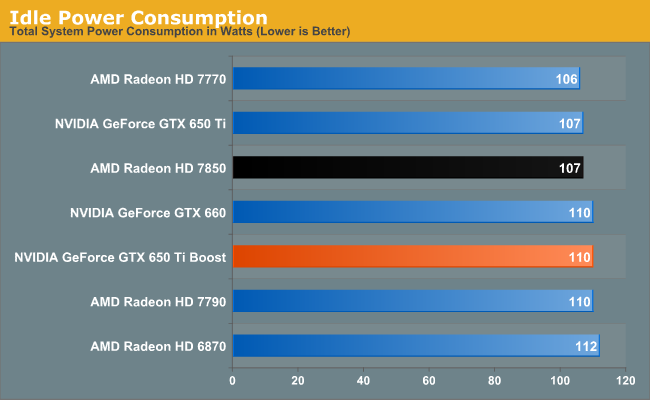
Starting as always with idle power, 110W at idle is par for the course for most NVIDIA cards. With the reactivation of the 3rd ROP partition the GTX 650 Ti Boost gives up the slight advantage the GTX 650 Ti gained here.
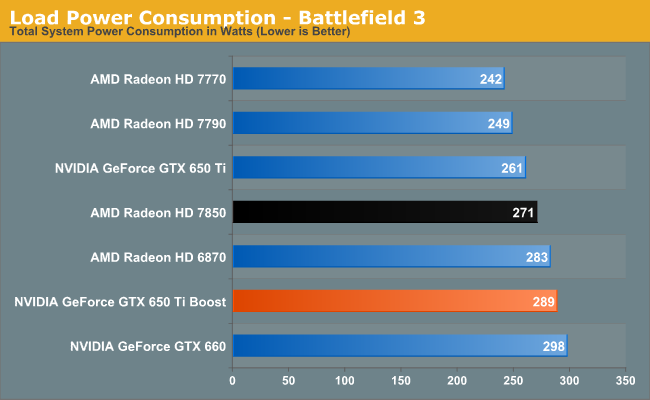
Moving on to our first and arguably most important load power test we have BF3. Power consumption in BF3 scales slightly with performance due to the extra work required of the CPU to feed more frames to a video card, but it usually paints some clear trends and this is no exception. NVIDIA may only be giving the GTX 650 Ti Boost a official TDP 6W lower than the GTX 660, but it’s clear power consumption is at least a little bit lower than that; we’re seeing 289W at the wall versus 298W for the GTX 660. On the other hand these results are 28W higher than the GTX 650 Ti, and even 18W higher than the 7850, never mind the 7790. The GTX 650 Ti Boost’s performance here is well ahead of everything other than the GTX 660, so this jump in power consumption does come with a performance boost, but it serves as a reminder that there is a tradeoff to be made. In the case of the GTX 650 Ti Boost, we’re seeing it pull away a bit from the efficiency curve set by NVIDIA’s other products.
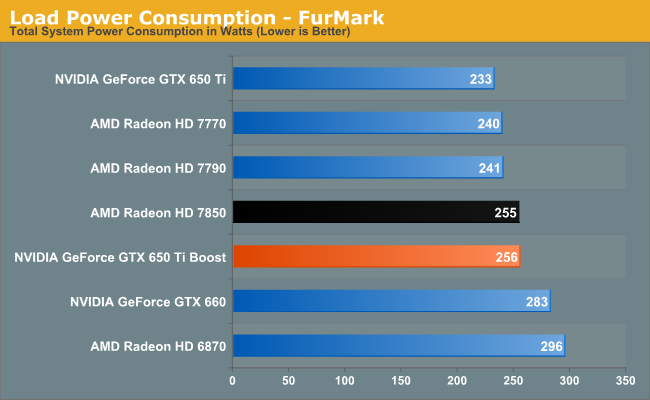
As for power consumption under FurMark, we’re seeing the more muted results for the GTX 650 Ti Boost. Here it’s roughly halfway between the GTX 650 Ti and GTX 660, and probably should be a bit higher still. The fact that there’s a difference (at the wall) of 27W between the GTX 660 and GTX 650 Ti Boost is more than we would except, and more than makes sense for cards that are identical except for a single fused off SMX. So we may also be seeing chip-to-chip variation play a part here. In any case, power consumption is also similar to the 7850, but this is one of those scenarios where we put more faith in the BF3 numbers than the FurMark numbers; NVIDIA appears to just outright be more aggressive on throttling here.
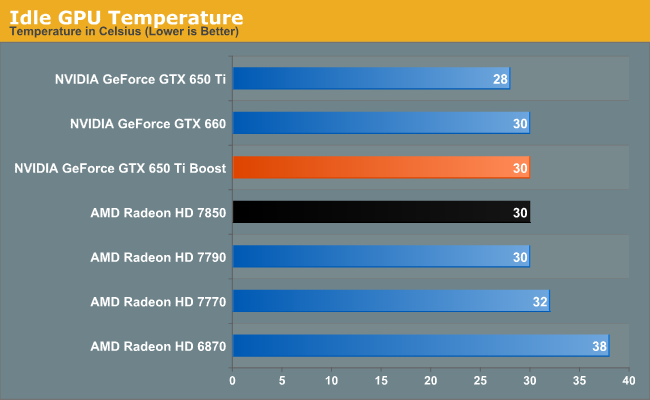
Utilizing the same cooler as the GTX 660, there’s no surprise here in seeing the GTX 650 Ti Boost hit the same 30C idle temperatures.
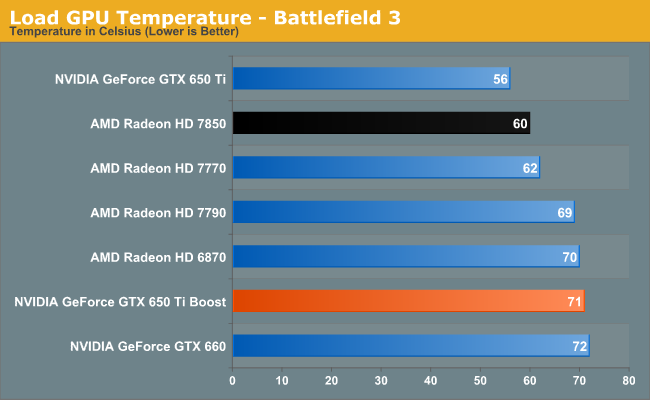
Similarly, our temperature results here closely parallel the GTX 660’s under load. The GTX 650 Ti Boost consumes a bit less power than the GTX 660, and doesn’t get quite as warm as a result. The large jump from the GTX 650 Ti comes as a bit of a shock to the eyes at first, but as the GTX 650 Ti Boost is a blower and one with a conservative fan curve at that, this is to be expected.
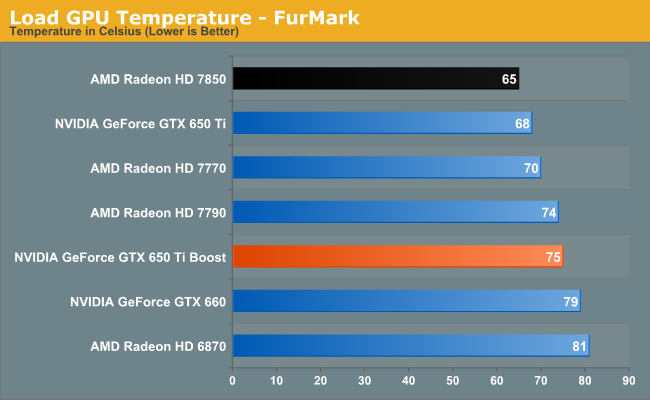
With FurMark we see temperatures go up, but for the most part things are consistent with what we saw under BF3. The larger gap between the GTX 650 Ti Boost and GTX 660 reflects the larger gap in power consumption we saw earlier.
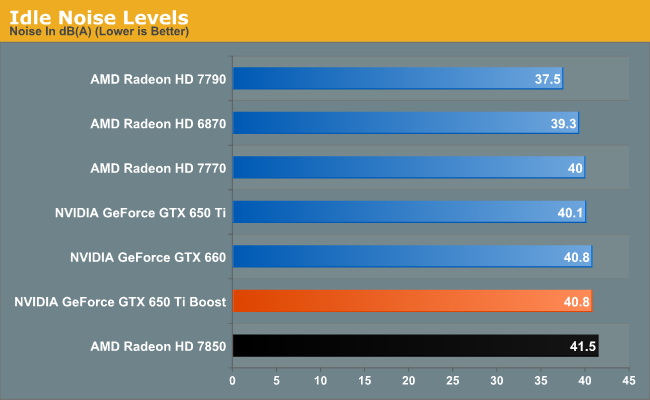
Just as with idle temperatures, the same GPU on the same cooler means we’re looking at the same idle noise temperatures. The blower NVIDIA uses here is quite good, but it can’t compete with simple open-air coolers like the 7790’s.

There’s a clear cutoff here between the open-air coolers and the blowers. The GTX 650 Ti Boost is quite a bit faster than something like the 7790 here, but the difference in noise is remarkable. Some of NVIDIA’s partner cards should fare much better here as they pack open-air coolers, with the usual tradeoff of giving up being fully-exhausting coolers. Still, this is a reminder that the GTX 650 Ti Boost pulls back from the efficiency curve a bit; it’s about 15% slower than the GTX 660 but no quieter for it.
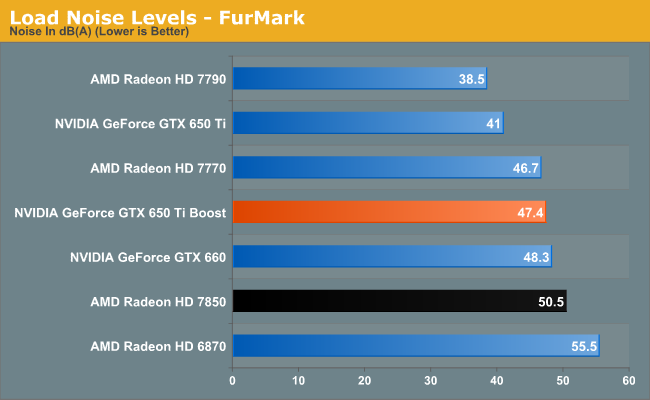
Finally we have load noise under FurMark. NVIDIA’s more aggressive throttling here means that our results don’t jump up to much from BF3. The GTX 650 Ti Boost does finally end up being a bit quieter than the GTX 660 due to the former’s lower power consumption, and this is the only time we see the GTX 650 Ti Boost gain an edge on the 7850 in power/temp/noise.










78 Comments
View All Comments
Bob Todd - Tuesday, March 26, 2013 - link
More data points are usually a good thing, but can I ask what you'd use that for? Since you can't install one in the other, beyond the novelty of knowing how close a midrange desktop card is to a halo mobile part I'm curious to know what you want out of it. It seems like on the mobile side most parts are 2-3 rungs below the desktop part of the same name throughout the lineup.Hrel - Tuesday, March 26, 2013 - link
I base card recs on how long they intend to keep it. On a budget? Ok, get something that will run 1080p for a year or two. 1GB 650 ti or 7790. Idk, I'd have to look at those two to really know between that. But then after that point spend more a 2GB card with a 256bit memory interface. (GTX660 192bit, WTF Nividia?) BUT, if you have some more money and want to keep the card 4 years or more, get the 7850. The 7850 will be faster now, last longer. But whatever card you'd replace the 650 ti with in a year or two for the same price will be even faster than that.I really don't like where the GPU market is right now. It feels stagnant. Nothing is really a good deal. Like you guys said, there is no sweet spot. The 8800GT was the card to get after the price dropped below 150. Same for the GTX460. Now to get that level of performance they expect you to shell out 220 bucks. Fuck that. I say, for now, either keep your current card or buy the cheapest one you can possibly stomach. This market needs to straighten itself out again.
I'm keeping my GTX460 until I literally can't run games anymore. Don't really care if I have to turn off AA in new titles. Neither company has given me a reason to upgrade. Sub 200 used to be competitive.
just4U - Wednesday, March 27, 2013 - link
Well.. generally speaking the 660 and the 7870 are currently enjoying the sweet spot. Neither card breaks the bank and the trade off in the +$300 range isn't so great to be a game breaker.The 460 was a $240 card when it launched and both of the ones I mentioned can be had for $220 if you look around.. (not including mail in rebates etc or game bundles). On average their 70% faster than 460 but over the past few years there's been a focus on loading temperatures, power consumption, and other features.. which is something that got kick-started around the time of the 460. Right now it's not giant leaps forward but rather, several steps to the side with a few steps forward in performance.
just4U - Wednesday, March 27, 2013 - link
Also.. if the 460 was your last purchase over the 8800 than your buying every third generation.. For you that wont come up until the next line-up/fall refresh.Calinou_ - Wednesday, March 27, 2013 - link
Want a large memory bus for cheap? Get an used GTX 570, then you have a 320 bit memory bus for the price of a 650 Ti. Then deal with the 250W in full load. :DShadowmaster625 - Tuesday, March 26, 2013 - link
The 7850 is a 10% larger die. So with all things being equal you can expect roughly 10% more performance. Both chips contain significant fused off sections but the amount that is fused off is roughly the same in percentage terms.The 7850 at stock is leaving an awful lot of performance on the table. You can tell this just by looking at the power consumption. Overclock the 7850 until its power consumption matches this new nvidia card, and how much performance differential are we now talking about? Well over 10% I'm sure...
The 650 Ti Boost is clearly more aggressively timed and configured, to squeeze out more dollars out of the enthusiast's pocket and into Nvidia's. The fact that the review doesnt really mention any of this is kind of surprising. I would say the 7850 is a better deal, based on the assumption that it has more overclocking overhead. Given the same 28nm process vs the difference in die sizes, that is surely a safe assumption.
mczak - Wednesday, March 27, 2013 - link
7850 doesn't have larger die. Pitcairn is quoted as 212mm^2 whereas gk106 is actually 221mm^2 (though the difference might be just be measuring differently, i.e. including the empty space at the edges or not if those are official, not measured, figures). Pitcairn does have 10% more transistors though (I guess for whatever reason amd could pack them more densely overall).But yes pitcairn is faster than gk106 overall. The reason the gtx660 loses to hd7870 but the gtx650ti boost is very close to hd7850 is of course that hd7850 is a hd7870 with 20% less shader units and 14% less clocks, whereas the 650ti boost is a 660 with 20% less shader units but same clocks. And yes this shows in overclocking potential and perf/w.
royalcrown - Tuesday, March 26, 2013 - link
Too many cards, just buy a 660 !Spunjji - Wednesday, March 27, 2013 - link
Too many cards, just buy a 7870!FTFY ;)
silverblue - Tuesday, March 26, 2013 - link
Nice card. Okay, the power draw is a bit of a downside, meaning we've got a 680-7970-esque comparison again between the 7850 and 650 Ti Boost where the former performs a little better in general whilst using less power, however considering the gap to the 660 isn't that big, is it worth the extra money?I can definitely see people buying these; that extra 1GB will certainly help in time.